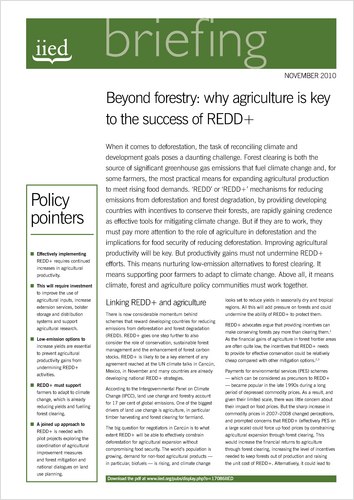Poverty and sustainable development impacts of REDD architecture
-----------------
Reducing deforestation and forest degradation has become a major climate and development issue. The conversion of natural forests and woodlands, particularly in the Tropics is estimated by the IPCC to account for 17-18 per cent of global greenhouse gas emissions, and the forest-dependent poor number over a billion. The ongoing negotiations on a REDD mechanism offer a way for incentivizing forest conservation that could bring benefits to developing countries with forest cover. But the division of benefits both between countries and between different stakeholders and types of forest resource user within countries will depend on the rules and design of REDD at the international and national and subnational levels.
Poverty and sustainable development impacts of REDD architecture: options for equity, growth and the environment is a multi-country project led by the International Institute for Environment and Development (IIED, UK) and the University of Life Sciences (Aas, Norway) which aims to increase understanding of how different options for REDD design and policy at international, national and sub-national level will affect achievement of greenhouse gas emission reduction and co-benefits of sustainable development and poverty reduction. The project is funded by the Norwegian Agency for Development Cooperation (Norad) as part of the Norwegian government’s Climate and Forest Initiative.
The analysis, strategy and policy development is being conducted in collaboration with local partners in Ghana, Tanzania, Uganda, Vietnam and Brazil. As well as examining the internal distribution and allocation of REDD payments under different design option scenarios at both international and national level, the project is working with selected REDD pilot projects in each of the five countries to generate evidence and improve understanding on the poverty impacts of REDD pilot activities, the relative merits of different types of payment mechanisms and the transaction costs.
Sub-Saharan Africa has been given special attention because this region is considered to have the greatest gaps in capacity to quantify and analyse the likely development impacts of REDD. Brazil and Vietnam have been included because both countries have implemented policies and programmes that are already reducing deforestation or increasing forest cover. This is particularly in the State of Amazonas in Brazil where the Bolsa Floresta programme is rewarding forest communities for avoiding deforestation. In Vietnam the government has a five million hectare reforestation programme and new policies that have implemented payments for ecosystem services. This allows the project partners to benefit from exchange of experience. In August this year, the project partners made a visit to some communities participating in the Bolsa Floresta Programme in Amazonas, Brazil, to see for themselves how a REDD scheme can operate in practice.
Location
The project is focusing on five countries: Brazil, Ghana, Tanzania, Uganda and Viet Nam.
Dates
Aims
The project aims to increase understanding of how different options for REDD design and policy at international, national and sub/national level will affect achievement of greenhouse gas emission reduction and co-benefits of sustainable development and poverty reduction.
As well as examining the internal distribution and allocation of REDD payments under different design option scenarios at both international and national level, the project is working with selected REDD pilot projects in each of the five countries to generate evidence and improve understanding on the poverty impacts of REDD pilot activities, the relative merits of different types of payment mechanisms and the transaction costs.
Partners
Fundação Amazonas Sustentável (Brazil)
Hamilton Resources (Ghana)
SNV (Viet Nam)
Sokoine University of Agriculture, Faculty of Forestry and Nature Conservation (Tanzania)
Makerere University, Faculty of Forestry and Nature Conservation (Uganda)
Contact
Maryanne Grieg-Gran, Principal Economist, Sustainable Markets Group, Environmental Economics
Funded by
Beyond forestry: why agriculture is key to the success of REDD+
When it comes to deforestation, the task of reconciling climate and development goals poses a daunting challenge. Forest clearing is both the source of significant greenhouse gas emissions that fuel climate change and, for some farmers, the most practical means for expanding agricultural production to meet rising food demands. 'REDD’ or ‘REDD+’ mechanisms for reducing emissions from deforestation and forest degradation, by providing developing countries with incentives to conserve their forests, are rapidly gaining credence as effective tools for mitigating climate change. But if they are to work, they must pay more attention to the role of agriculture in deforestation and the implications for food security of reducing deforestation. Improving agricultural productivity will be key. But productivity gains must not undermine REDD+ efforts. This means nurturing low-emission alternatives to forest clearing. It means supporting poor farmers to adapt to climate change. Above all, it means climate, forest and agriculture policy communities must work together.
---------------


